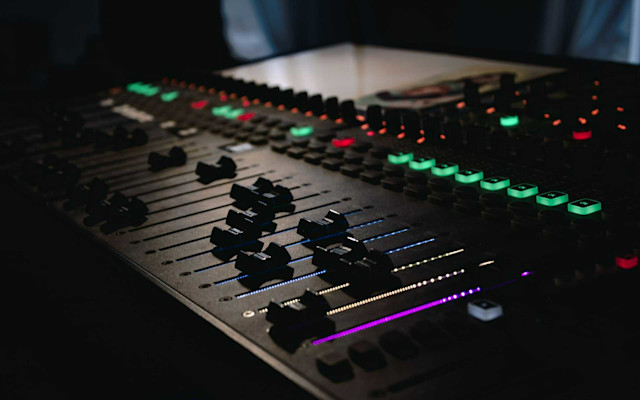11 Tips How To Fix Recording Latency in Your DAW
November 17, 2023 | Anton Berner

You play. You wait. Then you hear the sound.
Trying to make a song like this just isn’t going to work.
If you’re dealing with irritating stutters and delays between your recording signal and the audible playback of those performances, you’ve come to the right place.
Today, we’re going to talk about recording latency and what steps you can take to start reducing DAW latency in Soundtrap.
What is Latency?
The simplest way to define latency is that it is the time (measured in milliseconds) that it takes for your input (MIDI keyboard, guitar, or mic) to get to your output (speakers or headphones). In worst-case scenarios, this practically means that you, as the user, often have to manually re-align your performances to the beat of your song or the rest of the music in your project. Latency itself is impossible to eliminate. Fortunately, the human brain doesn’t really register any latency until it is up to 20 to 30 milliseconds long. If it’s noticeable, you’re likely facing much higher delays of 200 or even 300 milliseconds.
So, if you’ve been noticing a delay in your recordings, latency is the likely culprit.
Let’s fix it.
Buffer size adjustment in DAW
When audio is processed through a DAW, your computer’s audio interface converts its analog data into digital data. This digital data is then processed in bite-sized chunks and processed in sequence using a virtual container known as a buffer.
This buffer facilitates smoother and more efficient processing. One way to reduce latency is to essentially shrink the size of this container so that your computer processes bigger pieces of the audio data at one time. This will use more computer resources, and if your device is not powerful enough, you could experience sound dropouts and glitches.
If your DAW has an option for reducing the buffer size, you could try doing this to reduce your latency. However, as Soundtrap is a browser-based DAW, our platform does not include this setting. The following are some of the best ways to improve latency in Soundtrap.

A bad connection could be the culprit behind that annoying recording delay.
Top 11 Tips For Enhancing Recording Performance in DAW
1. Check Your I/O Devices
One of the most common issues that can cause latency is with your audio devices. A bad connection could be the culprit behind that annoying delay.
Check all your cables and ensure that everything is properly connected. Furthermore, latency can also be introduced when using wireless audio devices, like Bluetooth headphones or speakers.
If you’re getting a lot of latency using these devices, try moving to a wired connection. This is often a quick and easy way to reduce latency when using Soundtrap.
2. Use A Dedicated Audio Driver
In some operating systems, you can download and utilize a dedicated virtual audio driver that you can use to control settings like your audio buffer.
AISO4ALL is a common option for Windows computers that enables you to do this. Macs utilize a software called Core Audio, which enables extremely low latency recording and shouldn’t require any changes to their buffer size.
3. Use A Dedicated Audio Interface
Another option is to utilize a dedicated audio interface for audio interface latency management. There are many different kinds of interfaces available on the market today, but nearly all of them process audio faster than the typical built-in audio interface.
Plus, many of these devices are cross-compatible with all the major operating systems, including Windows, Mac, and Chromebook.
Using a device like this will also reduce latency if your computer’s hardware and processing power are being overwhelmed.
Furthermore, many of these devices include a “Direct Monitoring” feature that routes your audio signal directly back to your headphones so that you can hear your recording with minimal latency.
This is definitely a feature to utilize while recording if your device supports it.
4. Use A Browser and OS that Supports Direct Monitoring
Direct monitoring is supported on some devices and browsers and reduces latency by transmitting the direct, unprocessed signal from your audio interface to your headphones or speakers.
Mac OS and Chrome support monitoring. In addition, the mobile iOS Soundtrap application also supports monitoring.
Other device and OS combinations may still work with Soundtrap, but you may have slightly higher latency when using the application.
5. Update and Restart Your Browser
Soundtrap is different from other standard digital audio workstations (DAW) in that it is browser-based. This means that the performance of your browser has a direct impact on the performance of the system.
Sometimes, a simple way to reduce latency is to just try updating and restarting your browser. The easy way to see if Chrome needs an update is to look up to the right-hand corner of the browser window.
Right next to your profile picture will be the “More” icon with three small dots stacked vertically. If this icon is green, an update was released 2 days ago. If it is orange, an update was released 4 days ago.
Finally, if it is red, an update was released at least a week ago. Keeping your browser up to date is great for performance and keeping your browsing experience secure and optimized.
6. Try Using A Private/Incognito Browser Window
As you browse the internet, your browser stores data used for various purposes, such as targeted advertising or enabling the “remember me” option on websites.
This data can sometimes cause issues for browser-based applications. Fortunately, there’s a simple workaround.
Just try opening the application in an “Incognito” browser window. This can be done on any browser and is provided as a feature to offer more private browsing on shared devices.
On Chrome, simply click the three-dot icon in the upper right corner of the window. The third option from the top will be “New Incognito Window.” Click that, and you’re ready to go!
7. Clear Your Browser’s Cache Files
Aside from using an Incognito window, you could also simply clear your browser’s cache files to free up resources and improve the performance of Soundtrap.
In Chrome, click on the “More” icon with the three dots, and then go down to “More tools > Clear browsing data.” You’ll be presented with a few options, and you can then click “Clear data.”
8. Try Using A Different Internet Connection
Because Soundtrap is based in the cloud, your internet connection plays a part in latency. Even if you can manage zero latency between your audio device inputs and outputs, your signal still needs to be routed through the application over the Internet.
The point is that you might need to change your internet connection to achieve lower latencies when recording.
Consider using a phone hotspot or using some kind of faster connection just for recording, and then move to editing using your normal internet connection.
9. Close Un-Used Tabs and Turn Off Power-Consuming Applications
Programs that take a lot of CPU and computing power can slow the performance of your DAW.
If you’ve got a problem with delays or glitches, closing these programs can sometimes help. Additionally, look at the tabs you have open on your device.
Even with Chrome’s power-saving features, these tabs can still hog computer resources, so be sure to close them if you don’t need them.
10. Take Advantage of Soundtrap’s Optimization Features
Soundtrap includes some ways to achieve optimization for low latency and free up your CPU to process data faster.
One of these options is the “Sound quality” option. Setting it to low by going to Setting > Sound quality > Low can help improve the performance of Soundtrap.
Another option is to use the “Freeze track” feature. Apply Freeze track to a track in your project locks that track out of editing temporarily while simultaneously reducing CPU usage for that track significantly.
You can easily tell which tracks are “frozen” by the snowflake icon that will show above the instrument icon on that track.
To freeze a track, click on the ellipses menu in the track header and select “Freeze track.” To unfreeze a track, use the same menu and select “Unfreeze track.”
11. Invest In A Dedicated Low-latency monitoring setup
Ultimately, a more powerful computer with better hardware and a better audio driver is going to be one of the best ways to permanently improve the audio latency problem.
The chain from your instrument or input device to your output system is a long and complex process that is impacted by several important hardware components like your RAM and CPU.
Generally, we’ve found that Mac OS performs better with Soundtrap and has fewer latency problems than other operating systems like Windows or Chromebook.
Macs are also designed with some of the most advanced and feature-rich sound drivers and are considered the industry standard in music production.
To Sum It All Up
So, here’s a quick list of all the steps we covered in this article in order to help reduce recording latency in Soundtrap.
Check your I/O Devices
Use A Dedicated Audio Driver
Use A Dedicated Audio Interface
Use A Browser and OS That Support Direct Monitoring
Update and Restart Your Browser
Try Using A Private/Incognito Window
Clear Your Browser’s Cache
Try Using A Different Internet Connection
Close Un-Used Tabs and Turn Off Power-Consuming Applications
Take Advantage of Soundtrap’s Optimization Features
Invest In More Powerful Hardware
Each of these steps can go a long way in minimizing recording delay. There are latency-free recording techniques, but this requires the right hardware, as we have discussed.
Even these “real-time recording solutions” do not eliminate latency. However, the zero-latency monitoring that is provided by some operating systems can dramatically reduce delay. Have fun creating!
For more helpful tips, tricks, and information, check out our blog.
AUDIO RECORDINGS - Setup, Connecting Devices and Recording
About the author
Anton Berner is a music producer, audio engineer, and songwriter from Stockholm, Sweden. He's produced hip-hop & rap music since the early 2000s and his expertise is in vocal mixing and sample-based beat production. Anton is also the SEO & Content Manager @ Soundtrap and manages the blog and newsroom.
Soundtrap — the online music studio
Making music is more than just a hobby — it’s a form of self-expression, a way to unleash your creativity, and a means for you to bring your unique voice to the world.
Soundtrap is the ultimate audio production software for music makers and producers to easily collaborate and create music online, with thousands of audio loops, instruments, and samples only a click away.